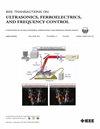Deep Beamforming for Real-Time 3-D Passive Acoustic Mapping With Row-Column-Addressed Arrays
IF 3
2区 工程技术
Q1 ACOUSTICS
IEEE transactions on ultrasonics, ferroelectrics, and frequency control
Pub Date : 2024-12-30
DOI:10.1109/TUFFC.2024.3524436
引用次数: 0
Abstract
Passive acoustic mapping (PAM) is a promising tool to monitor acoustic cavitation activities for focused ultrasound (FUS) therapies. While 2-D matrix arrays allow 3-D PAM, the high channel count requirement and the complexity of the receiving electronics limit their practical value in real-time imaging applications. In this regard, row-column-addressed (RCA) arrays have shown great potential in addressing the difficulties in real-time 3-D ultrasound imaging. However, currently, there is no applicable method for 3-D PAM with RCA arrays. In this work, we propose a deep beamformer for real-time 3-D PAM with RCA arrays. The deep beamformer leverages a deep neural network (DNN) to map radio frequency (RF) microbubble (MB) cavitation signals acquired with the RCA array to 3-D PAM images, achieving similar image quality to the reconstructions performed using the fully populated 2-D matrix array with the angular spectrum (AS) method. In the simulation, the images reconstructed by the deep beamformer showed less than 13.2% and 1.8% differences in the energy spread volume (ESV) and image signal-to-noise ratio (ISNR), compared with those reconstructed using the matrix array. However, the image reconstruction time was reduced by 11 and 30 times on the CPU and GPU, respectively, achieving 42.4 volumes per second image reconstruction speed on a GPU for a volume sized基于行-列寻址阵列的实时三维无源声映射深度波束形成
被动声成像(PAM)是一种很有前途的工具,用于监测聚焦超声(FUS)治疗中的声空化活动。虽然二维矩阵阵列允许三维PAM,但高通道数要求和接收电子器件的复杂性限制了它们在实时成像应用中的实际价值。在这方面,行-列寻址(RCA)阵列在解决实时三维超声成像的困难方面显示出巨大的潜力。然而,目前还没有适用于RCA阵列三维PAM的方法。在这项工作中,我们提出了一种具有RCA阵列的实时三维PAM的深度波束形成器。该深度波束形成器利用深度神经网络(DNN)将RCA阵列获得的射频(RF)微泡(MB)空化信号映射到3-D PAM图像,获得与使用角谱(AS)方法完全填充的2-D矩阵阵列进行重建的图像质量相似的图像质量。仿真结果表明,深度波束形成器重建的图像与矩阵阵列重建的图像相比,能量扩散体积(ESV)和图像信噪比(ISNR)的差异分别小于13.2%和1.8%。然而,在CPU和GPU上的图像重建时间分别减少了11倍和30倍,在GPU上实现了每秒42.4个卷的图像重建速度,而卷的大小为128\times 128\times 128$。实验数据进一步验证了深波束形成器在三维空间中精确定位MB空化活动的能力。这些结果清楚地证明了利用RCA阵列和基于神经网络的波束形成器实时和三维监测MB空化活动的可行性。
本文章由计算机程序翻译,如有差异,请以英文原文为准。
求助全文
约1分钟内获得全文
求助全文
来源期刊
CiteScore
7.70
自引率
16.70%
发文量
583
审稿时长
4.5 months
期刊介绍:
IEEE Transactions on Ultrasonics, Ferroelectrics and Frequency Control includes the theory, technology, materials, and applications relating to: (1) the generation, transmission, and detection of ultrasonic waves and related phenomena; (2) medical ultrasound, including hyperthermia, bioeffects, tissue characterization and imaging; (3) ferroelectric, piezoelectric, and piezomagnetic materials, including crystals, polycrystalline solids, films, polymers, and composites; (4) frequency control, timing and time distribution, including crystal oscillators and other means of classical frequency control, and atomic, molecular and laser frequency control standards. Areas of interest range from fundamental studies to the design and/or applications of devices and systems.

 求助内容:
求助内容: 应助结果提醒方式:
应助结果提醒方式:


